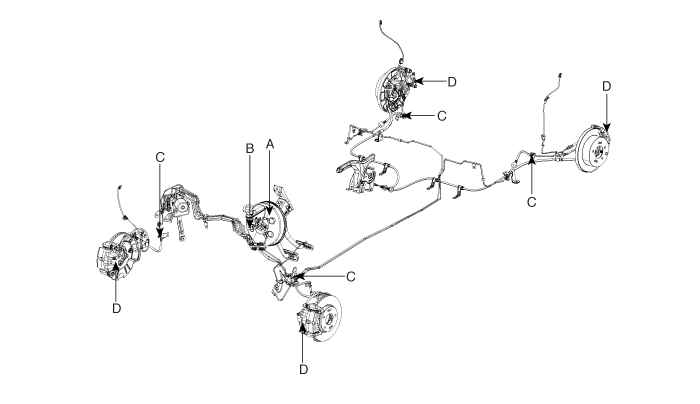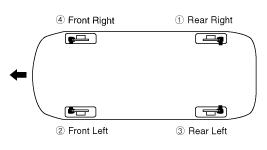 Hyundai Veloster: Description and Operation
Hyundai Veloster: Description and Operation
Operation and Leakage Check
| Check all of the following items: |
|
Component |
Procedure |
||||
|
Brake Booster (A) |
Check brake operation by applying the brakes during a test drive.
If the brakes do not work properly, check the brake booster. Replace the
brake booster as an assembly if it does not work properly or if there are
signs of leakage. |
||||
|
Piston cup and pressure cup inspection (B) |
|
||||
|
Brake hoses (C) |
Look for damage or signs of fluid leakage. Replace the brake hose
with a new one if it is damaged or leaking. |
||||
|
Caliper piston seal and piston boots (D) |
Check brake operation by applying the brakes. Look for damage or signs of fluid leakage. If the pedal does not work properly, the brakes drag, or there is damage or signs of fluid leakage, disassemble and inspect the brake caliper. Replace the boots and seals with new ones whenever the brake caliper is disassembled. |

| Brake System Bleeding |
|
| 1. |
Make sure the brake fluid in the reservoir is at the MAX(upper)
level line.
|
| 2. |
Have someone slowly pump the brake pedal several times, and then
apply pressure.
|
| 3. |
Loosen the right-rear brake bleed screw (A) to allow air to escape
from the system. Then tighten the bleed screw securely.
[Front disc brake]
[Rear disc brake]
|
| 4. |
Repeat the procedure for wheel in the sequence shown below until
air bubbles no longer appear in the fluid.
|
| 5. |
Refill the master cylinder reservoir to MAX(upper) level line.
|
 Brake System
Brake System
...
 Brake Booster. Components and Components Location
Brake Booster. Components and Components Location
Components (1)
1. Brake booster
2. Master cylinder assembly
3. O-ring
Components (2)
1. Vacuum pump
2. Bracket
...
See also:
How vehicle audio works
AM and FM radio signals are broadcast from transmitter towers located around
your city. They are intercepted by the radio antenna on your vehicle. This signal
is then received by the radio and s ...
Climate control air filter
The climate control air filter installed behind the glove box filters the dust
or other pollutants that come into the vehicle from the outside through the heating
and air conditioning system. If ...
Troubleshooting
Troubleshooting
Problem Symptoms Table
Use the table below to help you find the cause of theproblem. The numbers
indicate the priority of the likecause of the problem. Check each p ...
Categories
- Hyundai Veloster Manuals Home
- Hyundai Veloster 2010-2017 Owner's Manual
- Hyundai Veloster 2010-2017 Service Manual
© 2011-2025 Copyright www.hvmanual.com



